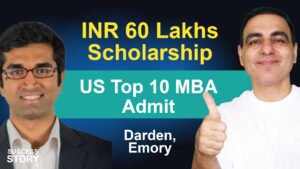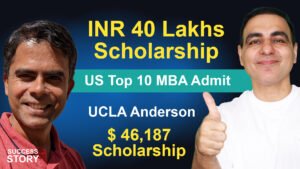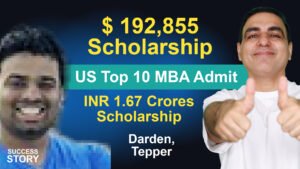Vikram’s story is proof that with the right strategy, even an IT tester can become a consulting‑ready MBA candidate and secure massive scholarship support. In under six months, he transformed vague post‑MBA goals into a compelling consulting narrative, turned his technical résumé into a strategic impact portfolio, and targeted schools that aligned perfectly with his new ambitions. The payoff? ₹1.5 crores in scholarships at top U.S. programs. Here’s the step‑by‑step of how he went from “techie” to “future business leader.”
Feeling Stuck in a Tech Bubble
At the outset, Vikram was senior in a global bank’s IT testing team—writing Cobol, JCL, and CICS scripts to ensure transaction systems ran smoothly. His technical chops were undeniable:
-
Automated test suites for treasury applications
-
Supported cash management and liquidity modules
-
Ensured 99.9% uptime for mission‑critical systems
Yet, he longed for a role with broader strategic scope—a position that let him shape business outcomes, not just validate code. His initial MBA goals reflected that confusion:
-
“I want a managerial position in IT.”
-
“I might explore asset management tech roles.”
-
“Consulting sounds interesting, but I’m not sure.”
Such generic objectives would not capture the imagination of top admissions committees. Without a clear narrative, Vikram risked blending into the crowd of tech applicants. The first order of business: set the right goals.
The Turning Point: Defining Ambitious, Cohesive Goals
Business schools prize candidates with well‑thought‑out career plans. Aiming for “manager in IT” is fine—but insufficiently distinctive. We guided Vikram through an intensive goal‑setting workshop to connect his technical background with emerging industry needs—namely, management consulting and sustainability.
Original vs. Recommended Goals
| Original Goal | Why It Fell Short | Recommended Goal |
|---|---|---|
| Short‑term: Managerial role in IT | Too generic; doesn’t leverage strategic potential | Short‑term: Generalist Consultant at McKinsey, Bain, or BCG—applying technical expertise to solve high‑value business problems |
| Long‑term: Grow within the IT industry | Lacked ambition and societal impact | Long‑term: Senior leadership in consulting, driving large‑scale business transformations and mentoring future tech leaders |
This recalibration empowered Vikram to pitch himself not as just another technologist, but as a strategic leader in the making—precisely the profile that top consulting firms and MBA programs covet.
Resume Transformation: From Code to Corporate Impact
A successful MBA resume tells a story of leadership, problem solving, and measurable business impact. Vikram’s original résumé, however, looked like a software manual:
Before
• Developed individual modules for treasury applications.
• Provided technical support for cash management and liquidity teams.
These bullets demonstrated skill, but not strategic value. We reframed them to capture outcomes:
| Before | After |
|---|---|
| Developed individual modules for treasury applications. | Led the development and integration of treasury modules for a major Spanish bank, streamlining cash‑flow reporting and boosting system efficiency by 20%. |
| Provided technical support for cash management teams. | Collaborated with cross‑functional teams in Zurich and New York to enhance liquidity reporting systems, reducing downtime by 35% and improving decision‑making speed. |
By quantifying improvements—20% efficiency gains, 35% downtime reduction—Vikram’s résumé evolved into a testament of his business impact, rather than a catalog of technical tasks.
Highlighting Transferable Skills
To bridge IT and consulting, we spotlighted three categories of transferable skills:
Analytical Problem Solving
His experience debugging complex systems became evidence of his ability to decompose business challenges and craft data‑driven solutions.
Client Engagement & Stakeholder Management
Work with global teams in Switzerland, Spain, and the U.S. framed as cross‑cultural collaboration—key for consulting projects.
Leadership & Project Management
Leading 4‑person test teams morphed into stories of steering multi‑regional initiatives, aligning stakeholders, and delivering under tight deadlines.
Each skill was woven into both résumé bullets and essays, illustrating how Vikram’s technical pedigree underpinned strategic leadership potential.
Crafting Essays That Captivate
A powerful MBA essay structure blends personal story, professional achievements, and future vision. Vikram’s essays followed a three‑act arc:
-
Hook: A vivid anecdote—such as troubleshooting a live vault system under executive scrutiny.
-
Journey: The strategic steps he took—organizing cross‑team war rooms, applying root‑cause frameworks, and iterating solutions.
-
Vision: How schools like Booth and Stern, with their analytics centers and social‑impact labs, would equip him to lead business transformation.
One Booth essay began:
“At 2 AM, alarms blared across the data center as NAV calculations failed. I led a multinational team through a hypothesis‑driven investigation, restoring accuracy within two hours and safeguarding $200 million in investor capital.”
This storytelling hooked readers and showcased his problem‑solving mettle.
Strategic School Selection & Scholarship Focus
Rather than chase top‑10 rankings blindly, we aligned school choices to Vikram’s goals:
| School | Key Strengths | Scholarship Award |
|---|---|---|
| Kelley | Strong consulting pathway, analytical focus | USD $54,150 (≈₹45 lakhs) |
| UIUC (Gies) | STEM‑designated, data analytics expertise | USD $35,000 (≈₹29 lakhs) |
| Boston University | Sustainability, social impact programs | USD $100,000 (≈₹83 lakhs) |
| Total | ≈₹1.5 crores |
Kelley’s consulting track, Gies’s STEM emphasis, and BU’s sustainability labs each mapped directly to his short‑ and long‑term ambitions, maximizing both fit and scholarship potential.
Admissions & Interview Mastery
Securing scholarships requires more than essays—it demands stellar interviews. Vikram prepared via:
-
Behavioral Drills: STAR‑formatted examples on leadership, conflict resolution, and ethics in crisis situations.
-
Case Study Practice: Structuring market‑entry and cost‑reduction cases, hypothesizing solutions, and quantifying impact.
-
“Why This School?” Pitches: Custom scripts referencing specific faculty research, elective courses, and extracurricular clubs.
Fifteen mock sessions sharpened his delivery, boosting his confidence and polish under pressure.
Key Takeaways for Aspiring MBA Candidates
-
Define Goals with Precision: Move beyond generic aspirations to roles that align with your strengths and market demand.
-
Quantify Your Achievements: Convert every technical bullet into a business outcome—percent improvements, cost savings, time efficiencies.
-
Select Schools Strategically: Prioritize programs whose core strengths and scholarship budgets match your goals.
-
Tell a Cohesive Story: Ensure essays, résumé, and interviews reinforce the same narrative arc of growth and future impact.
-
Invest in Interview Prep: Behavioral and case fluency can tip scholarship committees in your favor.
Vikram’s ₹1.5 crore scholarship haul demonstrates that with clarity, strategy, and transformation, technical professionals can become compelling MBA candidates—and business leaders in the making.
Ready to rewrite your own career story and secure life‑changing scholarships? Let’s make it happen—Contact Us to start your Global MBA Accelerator journey today






